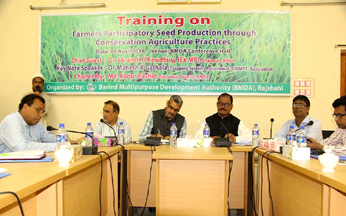RAJSHAHI, April 5, 2018 (BSS) -Time has come to wide-ranging and sustainable expansion and promotion of conservation agriculture (CA) based technologies in the drought-prone Barind tract to protect its soil health from further degradation.
Principles of conservation agriculture are: the use of reduced tillage, retention of some amounts of residues on the field, optimum use of natural resources, sustainable and profitable crop diversification and its rotation and judicious use of fertilizers and pesticides.
The observation came at a daylong training titled “Farmers Participatory Seed Production through Conservation Practices” organised by Barind Multipurpose Development Authority (BMDA) in its conference hall in the city on Wednesday.
BMDA Chairman Dr Akram Hossain Chowdhury addressed the meeting as chief guest with its Executive Director Engineer Abdur Rashid in the chair.
Superintending Engineers Dr Abul Kashem and Shamsul Huda, Principal Scientific Officer of Wheat Research Station Dr Ilias Hossain and Senior Scientific Officer of Bangladesh Agriculture Research Institute Dr Shakhawat Hossain also spoke.
During his keynote presentation, Mahesh Kumar Gathala, Cropping System Agronomist of CIMMYT, said conservation agriculture practices could be the effective means of utilizing the minimum amount of water for crop establishment in the present context of climate change especially unpredictable rainfall and unusual drought.
Some proven benefits of the conservation agriculture-based machinery such as power tiller operated seeder (PTOS) and bed former or planters included early planting, increased yields, reduce production costs and water requirement and help improve the environment by reducing the greenhouse gas emissions.
Raised-beds technology facilitates sowing without waste of time allowing crop growth to better match water availability. Bed planting improves water distribution and irrigation efficiency, gives better results in using fertilisers and pesticides and reduces weed infestation and crop lodging.
It saves crops from disturbance from rats. The pattern helps farmers save 30 percent irrigation water and 30 to 40 percent of seeds and fertilizers.
Dr Akram Chowdhury said demand for food production is gradually increasing to feed the population and more pressures are coming on per-unit cultivable land.
To this end, the new and updated technology is capable to enhance production and productivity in a cost-effective way, he said.
By using the new pattern of crop rotation, the huge tracts of land that remain fallow in the Barind after the harvest of transplanted Aman each year, could be used to grow wheat or lentil, followed by moog daal, by providing small irrigation facilities, added Dr Chowdhury.



